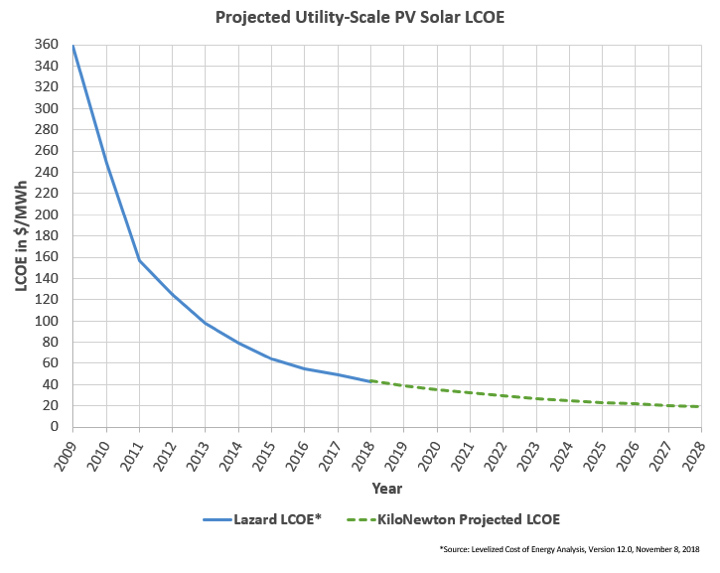“At the end of the day, [the Energy Transition Act] embraces compromise as a means of moving forward; it looks to unite state, customer, and utility interests under single cover, working to navigate a viable path out of the deep and tangled morass.” - JULIE MCNAMARA, UNION OF CONCERNED SCIENTISTS : SB 489 is the Clean Energy Catalyst New Mexico Needs
Read the full article here….
New Mexico, where KiloNewton calls home, is a historically economically depressed state. The state’s economy notoriously relies on Federal money, with two national labs (Sandia and Los Alamos), and numerous military bases. Aside from Federal money, the state relies heavily on the energy industry, primarily oil and gas. Yet legislation to move the state towards a renewable energy economy is working its way through Santa Fe after years of similar bills dying in committee. The Energy Transition Act (SB 489) is a multi-pronged approach towards meeting renewable energy goals and meeting the economic challenges that may come from that transition.
Part of the transition includes the closure of the Public Service Company of New Mexico’s (PNM) San Juan Generating Station, a coal-fired power plant near the town of Farmington in Northern New Mexico, by 2022, about 20 years before the end of its projected lifespan. The plant employs approximately 400 people directly, and the San Juan Mine, which solely supplies coal to the power plant, employs approximately another 360 people. For the small towns in Northern New Mexico, that makes the coal plant and mine the biggest employers of the area. Only a couple of years back, PNM’s plan was to keep the plant operating indefinitely. The concern in the region about closing the plant is prevalent, including among the Navajo Nation.
With New Mexico ranking near the bottom in employment and economic rankings, the question arises: why rock the boat?
The answer is that the boat was already rocking.
In 2017, PNM released an integrated resource plan that included an estimate showing the utility would save between $80 and $450 million in a 20-year period, savings that would be (eventually) passed onto PNM’s customers. PNM’s plan also calls for the utility to be completely coal-free by 2031, when its coal supply agreement ends with the Four Corners Power Plant. The economic evaluation by PNM shows that investing in new renewable facilities, supplemented (for now) with natural gas facilities for peak demand and existing nuclear generation, is cheaper in the long run than keeping the San Juan plant open and retaining investment in the Four Corners plant.
This isn’t just a PNM thing or utilities bowing to pressure. Coal plants all around the country are closing prematurely because they are no longer economically viable. Coal mines are feeling the pressure as well. The owner of the San Juan Mine, Westmoreland Coal, filed for bankruptcy last year.
But, the economic ship of New Mexico doesn’t solely reside on the prowess of PNM’s financial success. The economic impact of coal-fired generation plants closing goes beyond the cost of renewables compared to coal. The San Juan plant and the mine have high-paying jobs, tax revenue both to the state and locally, and other peripheral aspects like scholarships and charitable donations, that are not easily replaced.
These economic waves are already rocking the boat of New Mexico’s economy, and indeed might sink it if not addressed. That’s where the Energy Transition Act (SB 489) comes into play.
PNM has admitted that the debts involved with the San Juan plant, the cost of closing it down, and the investment required to replace the generation new resources will in the short-term result in higher rates for consumers. The Energy Transition Act addresses the financial aspects of PNM’s outstanding debt associated with the San Juan station, providing a way out to lessen the burden passed onto consumers.
More importantly, the bill sets aside money for severance and job training for those affected by the closing of the plant, including those working in the mine that serves San Juan. It requires that new generation facilities host apprenticeships, further developing a skilled labor pool and higher-paying jobs. And while encouraging job growth and stability, it also encourages innovations in technology as a way to ease the transition.
Along with the requirement the state achieve a 50 percent renewable energy portfolio by 2030, and 80 percent by 2040, the Energy Transition Act is powerful tool to not only keep the ship upright, but make it sail. While not as aggressive as the Green New Deal that is making headlines on the Federal level, it’s along the same vein. It doesn’t just require a transition to renewable energy, it creates a feasible path with the potential to lift the economics of New Mexico from the bottom rankings of the nation. In a broader view, it shows the economic promise of investment in renewable energy when an economically-depressed state embraces it over the sinking ship of coal.





























